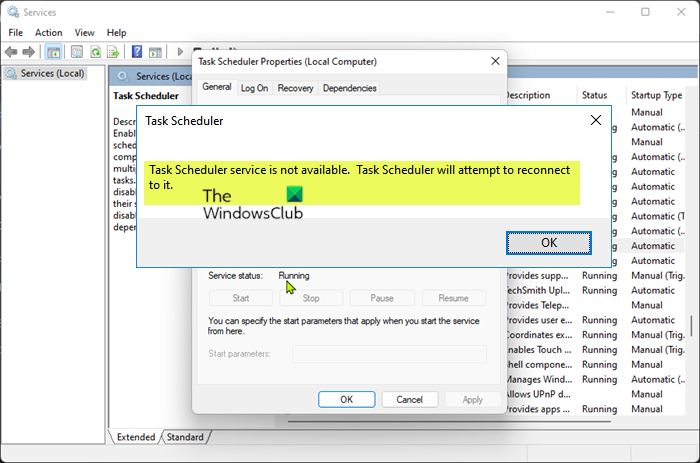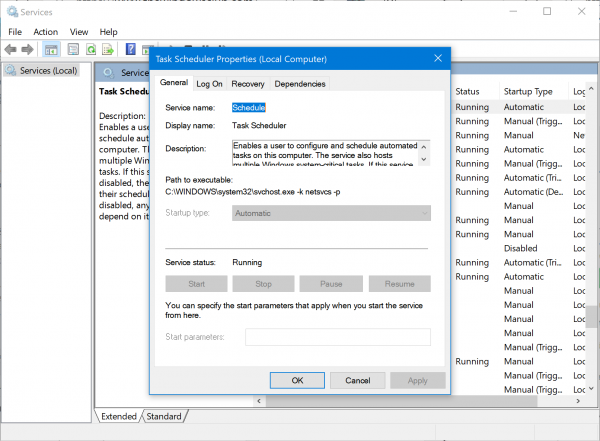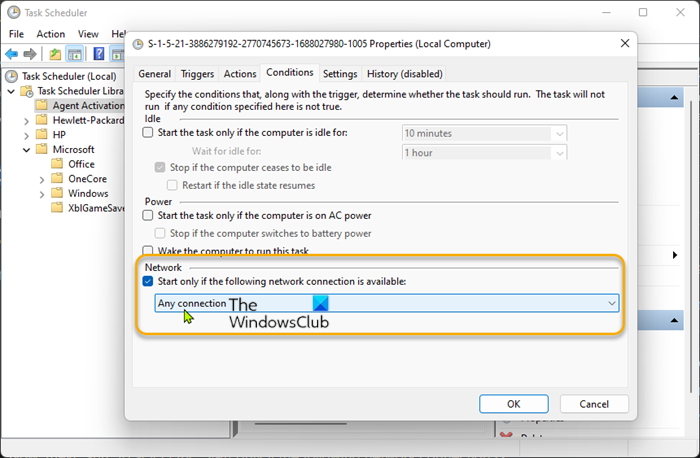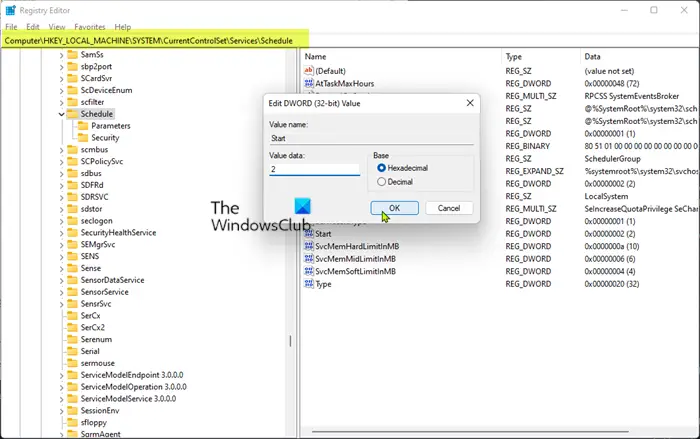Some PC users have reported that when they try to run some tasks created with Task Scheduler on their Windows 11 or Windows 10 computer, they get the error prompt with the message Task Scheduler service is not available. This post provides the most applicable solutions to this issue.

Task Scheduler service is not available. Task Scheduler will attempt to reconnect to it.
Task Scheduler service is not available
If you get the Task Scheduler service is not available when you try to run some tasks on your Windows 11/10 system, you can try our recommended fixes below in no particular order and see what works for you in resolving the issue on your device.
- Initial checklist
- Manually start Task Scheduler service
- Change the Task Conditions
- Create or modify Start registry key value for Task Scheduler
- Check for and delete corrupted Tasks
- Perform Reset This PC, Cloud Reinstall or In-place Upgrade Repair Windows
Let’s have a quick look at the description of the listed solutions.
1] Initial checklist
Some PC users reported they encountered this issue after installing a new update for Windows 11/10. So, if this case scenario applies to you, before you proceed with the fixes below, as a possible quick resolution, you can run SFC scan to fix any system file that might have been corrupted due to the ‘buggy’ update. You can also consider uninstalling the update on your device, or perform System Restore and select a restore point before installing the update. On the other hand, if your PC is not running the latest version/build, see if updating your system resolves the issue for you.
Related: Task Scheduler not running, triggering or starting programs
2] Manually start Task Scheduler service

We start off with the most obvious solution to the Task Scheduler service is not available, which is to manually start the Task Scheduler service. To perform this task, make sure you’re logged in as an administrator on your Windows 11/10 PC.
To manually start the Task Scheduler service, do the following:
- Press Windows key + R to invoke the Run dialog.
- In the Run dialog box, type services.msc and hit Enter to open Services.
- In the Services window, scroll and locate the Task Scheduler service.
- Double-click on the entry to edit its properties.
- In the properties window, click the drop-down on the Startup type and select Automatic.
- Next, make sure the service is started by clicking the Start button if not greyed out.
- Click Apply > OK to save changes.
- Restart PC.
Now, see if you can run the task successfully. If not, try the next solution.
Read: Task Scheduler Access is denied. Error code 0x80070005
3] Change the Task Conditions

Some affected PC users reported that by changing the conditions of the task they are trying to run, they were able to resolve the issue.
Do the following:
- Press Windows key + R keys to invoke the Run dialog.
- In the Run dialog box, type taskschd.msc and hit Enter to open Task Scheduler.
- In the left pane of Task Scheduler, expand the Task Scheduler Library.
- Now, select the folder that contains the task triggering the error.
- In the middle pane of the opened folder, right-click the task and select Properties.
- On the task Properties window, click Conditions tab.
- Now, under the Network section, make sure to select the Start only if the following network connection is available option.
- Next, from the drop-down located below to the above settings, select Any connection.
- Click OK.to save changes.
- Exit Task Scheduler.
- Reboot PC.
On boot check if the issue in highlight is resolved. If not, make sure to uncheck the above setting, and then proceed with the next solution.
Read: How to enable or disable Scheduled Task in Windows
4] Create or modify Start registry key value for Task Scheduler

Start is a type REG_DWORD which specifies how a particular service is loaded or started; in this case Task Scheduler service. If the service is a Win32 service, the value of Start must be 2, 3, or 4. This value entry is not used for network adapters.
This solution requires you to create or modify the Start registry key value for Task Scheduler service. To perform this task, do the following:
Since this is a registry operation, it is recommended that you back up the registry or create a system restore point as necessary precautionary measures. Once done, you can proceed as follows:
- Press Windows key + R to invoke the Run dialog.
- In the Run dialog box, type regedit and hit Enter to open Registry Editor.
- Navigate or jump to the registry key path below:
HKEY_LOCAL_MACHINE\SYSTEM\CurrentControlSet\Services\Schedule
- At the location, on the right pane, double-click the Start entry to edit its properties.
If the key is not present, right-click on the blank space on the right pane and then select New > DWORD (32-bit) Value to create the registry key and then rename the key accordingly and hit Enter.
- Double-click on the new entry to edit its properties.
- Input 2 in the Value data field.
- Click OK or hit Enter to save the change.
- Exit Registry Editor.
- Restart your PC.
On boot check if you can run the task without issues. Otherwise, continue with the next solution.
5] Check for and delete corrupted Tasks
There are 3rd-party tasks that might get corrupted, hence the issue you’re currently facing. In this case, you need to identify, then rename or delete the culprit task. To perform this task which requires you make changes to the registry, we recommend you first back up the registry or create a system restore point in case something goes wrong.
To check for and rename or delete corrupted Task in the Windows Registry, do the following:
- Open Registry Editor.
- Navigate or jump to the registry key path below:
HKEY_LOCAL_MACHINE\SOFTWARE\Microsoft\WindowsNT\CurrentVersion\Schedule\TaskCache\Tree
- At the location, on the left pane, right-click on Tree Key and rename it to Tree.old.
Now, open Task Scheduler and run the task to see if the error persists or not. If the error isn’t triggered, it means an entry under Tree key is corrupted and you need to identify and delete the entry.
- Again rename Tree.old back to Tree and expand this registry key.
- Under Tree registry key, suffix each key with .old and each time you rename a particular key run your task in Task Scheduler and see if the error is triggered.
- Repeat until the error message doesn’t appear.
- Now delete those entries causing the Task Scheduler error.
- Once done, exit Registry Editor and restart your PC.
The issue should now be resolved. If not, you can try the next solution.
Read: How to delete Scheduled Task in Windows
6] Perform Reset This PC, Cloud Reinstall or In-place Upgrade Repair Windows
Severe system file corruption or bad Windows image could be the culprit here. So, if nothing has worked so far up to this point, you can try Reset This PC, or Cloud Reinstall to reset every Windows component. If neither procedure worked to resolve the issue in hand, you may also try In-place Upgrade Repair and see if that helps.
Any of these solutions should work for you!
Related post: Task Scheduler not running or starting programs
How do you fix Task Scheduler started and then stopped?
Type Services.msc in Start Search, open the Services console, and then scroll down to Task Scheduler service, click on the service, and make sure the service is Running and Set to Automatic. Click the Dependencies tab, make sure those services are running too.
Fix: Task Scheduler failed to start, Event ID 101
How do I add a service to Task Scheduler?
Open Task Scheduler. In the right column window click on Create Task. In the General tab, type a name for the service. Enable the Run whether user is logged on or not and Run with highest privileges options.
Leave a Reply